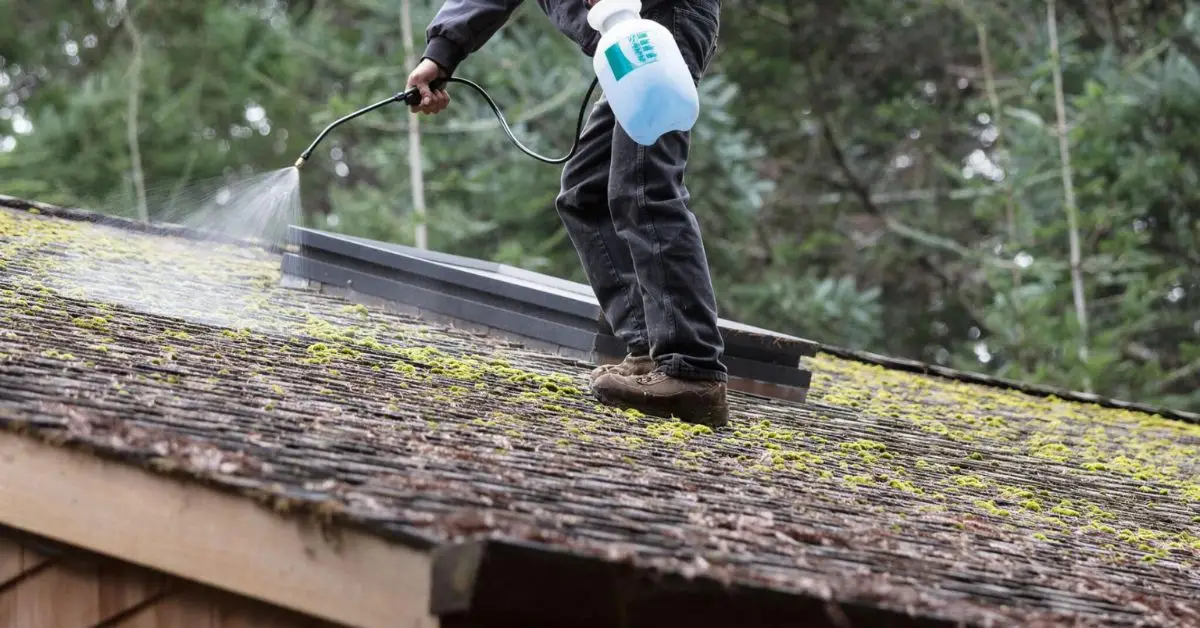Algae on Your Roof? Here Are 7 Fast Ways to Fix It
You’re not the only one who has seen those black spots or green streaks appear on your roof. Roof algae can be more than simply a cosmetic problem, and they are surprisingly frequent, particularly in humid settings. Although algae won’t necessarily ruin your roof right away, it can cause expensive damage over time, such as shingle degradation. The good news is that you can fix it without hiring a costly professional. Algae may actually be safely and successfully removed off your roof using a few easy do-it-yourself techniques.
I am aware that cleaning your roof may appear intimidating, but I assure you that it is not as difficult as you may imagine. I’ll show you seven easy, hassle-free ways to fix your roof without going over budget, regardless of your level of experience. Let’s explore how you can confidently and easily manage this typical home maintenance problem.
1. Use a Baking Soda and Water Solution
Baking soda may be your best friend if you’re searching for an easy, low-cost method of combating algae without using harmful chemicals. It is a mild yet powerful cleanser that effectively inhibits the growth of algae and is entirely non-toxic. Additionally, it’s a great option for homeowners who value environmentally responsible practices.
Why it works: Baking soda acts as a gentle abrasive to remove algae from the roof without causing shingles to become scratched or damaged. Baking soda is a safe option for most roofs because it won’t damage the integrity of your roofing materials like other stronger chemicals do.
Algal accumulation can be significantly reduced with routine roof repair. You should take easy precautions to keep algae at bay, just as you should be on the lookout for mold, which can infiltrate your home without anyone noticing. For example, you can learn how to avoid typical blunders that attract mold, which can help you avoid similar problems with your roof.
How to use it:
- Mix 1 cup of baking soda with 1 gallon of water.
- For best results, use a soft-bristled brush or spray bottle to apply the solution to the affected areas.
- Gently scrub or let it sit for 10 15 minutes before rinsing it off with water.
Without the use of harsh tools or hazardous chemicals, you’ll see the algae begin to break apart and wash away.
2. Apply a Vinegar and Water Mixture
Not only is vinegar great for your kitchen, but it’s also a great natural way to get rid of roof algae. When used properly, this technique is safe and effective for the majority of roofing materials. Additionally, it’s a fantastic choice if you want to remove algae from your roof without using chemicals.
Why this is effective:Acetic acid, which is found in vinegar, decomposes algae and eliminates the spores, stopping them from growing again. For homeowners who wish to combat algae head-on without using harsh chemicals, it’s the ideal substitute.
How to use it:
- Mix equal parts vinegar and water in a spray bottle.
- Spray the solution directly onto the algae, covering the areas thoroughly.
- Let it sit for about 20 minutes before rinsing with water. For stubborn patches, you might need to repeat the process.
The finest aspect? In addition to killing the algae, vinegar also serves as a natural repellant, preventing the emergence of new algae in the near future.
For homeowners who wish to combat algae head-on without using harsh chemicals, vinegar is the ideal substitute. Similar to this, taking a proactive stance is necessary when handling other typical home problems like plumbing leaks.Here is a plumbing leak repair guide that may be useful for house maintenance.
3. Try a Commercial Algae Cleaner
DIY solutions like vinegar and baking soda may not be sufficient for some people, particularly if the algae has been growing for a while or the infestation is very difficult to eradicate. Commercial algae cleansers can help with that. They are designed to address more serious algae issues and provide your roof with long-lasting protection.
Why this works: You don’t have to worry about commercial algae cleaners harming your shingles because they are made to be safe for the majority of roofing materials. These cleaners usually have built-in mold inhibitors to stop future growth, and they are more potent and efficient at getting rid of algae.
How to use it:
- Purchase a roof-safe algae cleaner (look for options specifically designed for your roof type).
- Follow the manufacturer s instructions for application.
- Most products require you to spray it on and let it sit, then rinse off.
Advice: Pressure Cleaning Guys is a reliable supplier of high-quality algae removers and offers instructions on how to clean your roof efficiently without causing any damage.
Although using a commercial cleaner is a quick remedy, keep in mind that these solutions are frequently made for long-term protection, so you’ll be stopping future algae growth.
DIY solutions like vinegar and baking soda may not be sufficient for some people, particularly if the algae has been growing for a while or the infestation is very difficult to eradicate. Commercial algae cleansers can help with that. Read this article to learn how to successfully address germ hotspots for a more severe cleaning assignment, such as eliminating hidden bacteria in your kitchen.
4. Use Pressure Washing (With Caution)
Although pressure washing may seem like a quick remedy for algae removal, it’s a technique that needs to be used carefully. A pressure washer can harm your shingles if it is done improperly, which could cause more issues later. Therefore, the secret to success is knowing how to use it safely.
Why this works: When algae development is extensive, pressure washing is a good way to get rid of it fast. If done incorrectly, though, it can also remove the shingles’ protecting granules. It all comes down to striking the ideal balance between strength and accuracy.
How to use it:
-
Set the pressure to low:
Always start with a lower pressure setting to avoid damaging your roof. Too much pressure can force water under the shingles, causing leaks and even lifting them. -
Work with the grain:
Aim the nozzle along the direction of the roof s grain, never directly up or down. This prevents water from getting trapped beneath the shingles. -
Use a wide-angle nozzle:
This helps distribute the pressure more evenly, making it gentler on the roof.
Important Tip: Areas with severe algae infestations or larger roofs benefit most from pressure cleaning. Just make sure you use the right methods to prevent harm.
Are you looking for additional advice on how to remove algae with pressure washing safely? You can find a great, comprehensive guide on roof cleaning methods from This Old House here.
5. Install Zinc or Copper Strips
Installing copper or zinc strips along your roof’s ridge is a long-term solution if you want to prevent the trouble of frequent algae cleanings. Ions released gradually by these strips stop algae from developing in the first place.
Why this works: The ions released by copper and zinc strips kill algae and stop it from growing again, which is why they are so effective. You won’t have to worry about regular maintenance because they do more than just clean your roof; they actively combat algae over time.
How to use it:
-
Install along the ridge of the roof:
Place the strips where the roof meets the ridge, ensuring they re securely attached. -
Simple to install:
Particularly on steep roofs, this solution is relatively easy to install and doesn t require much maintenance after that.
You can make sure that algae doesn’t have an opportunity to grow on your roof in the first place by installing these strips. It’s a preventative measure that will ultimately save you time and effort.
6. Use a Soft-Bristled Brush for Manual Scrubbing
Sometimes the simplest approach to algae removal is also the most successful. You may remove algae without harming your roof by using a soft-bristled brush. While it may take a little elbow grease, this tried-and-tested technique can tackle localized algae growth, leaving your roof looking fresh without the need for chemicals or heavy equipment.
Why this is effective:Gentle manual scrubbing ensures you don t damage your shingles, unlike harsher methods that might lift or crack the materials. It s an effective option for smaller, more targeted algae infestations.
How to use it:
-
Use a soft-bristled brush:
Gently scrub the algae away, being careful not to push too hard. -
Work in sections:
Focus on small areas at a time to ensure thorough cleaning. -
Rinse after scrubbing:
Use a hose to rinse off any leftover algae and debris once you re done.
This method is perfect for homeowners who prefer a hands-on approach and want a safe, controlled way to remove algae without risking any damage to their roof.
7. Clean Your Gutters Regularly
One of the easiest yet most overlooked methods to prevent algae growth on your roof is keeping your gutters clean. Clogged gutters trap water, which can lead to excess moisture on the roof, providing the perfect breeding ground for algae. This simple maintenance step can save you from bigger issues down the road.
Why this works:When gutters are clogged, water can t flow properly, and it begins to collect, pooling on your roof. This moisture allows algae to thrive and spread.
How to use it:
-
Clear gutters regularly:
Make a habit of cleaning your gutters at least twice a year more if you live in a leafy area. -
Check downspouts:
Ensure water flows freely through your gutters and downspouts to prevent any blockages.
Regular gutter cleaning not only helps prevent algae growth but also protects your roof from more serious damage, such as leaks and wood rot.
Things to Avoid When Removing Algae from Your Roof
When you re tackling roof algae, it s important to avoid a few common mistakes that can end up costing you more than just a cleaning session. Using improper techniques or harsh chemicals can lead to roof damage, which could require expensive repairs. Here are some key things to steer clear of:
What to avoid:
-
High-pressure washers:
While tempting, using a high-pressure setting can damage your shingles by forcing water under them or stripping off protective granules. -
Harsh chemicals like bleach:
Bleach can damage your roof s surface and harm the environment. It s better to use gentler, non-toxic alternatives that won t hurt your shingles or the surrounding landscape.
By avoiding these mistakes, you can safely and effectively remove algae without causing further harm to your roof.
How to Prevent Algae Growth on Your Roof in the Future
It s always better to be proactive than reactive when it comes to roof maintenance. Once you ve tackled the algae issue, take a few simple steps to prevent it from coming back. Regular roof upkeep can save you from having to repeat the algae removal process again.
Preventative steps:
-
Regular maintenance:
Keeping your roof clean and well-maintained is the best way to ensure algae doesn t return. Regular inspections help catch early signs of algae growth or moisture buildup. -
Proper ventilation:
Ensure that your attic and roof are well-ventilated. Good airflow helps keep the roof dry, reducing the moisture that algae needs to thrive. -
Algae-resistant shingles:
If you re replacing your roof, consider using algae-resistant shingles, which are designed to prevent future growth.
For a more in-depth look at roof cleaning and algae prevention,Roof Craftersprovides excellent resources on how to remove mold and algae effectively.
By installing copper or zinc strips along your roof s ridge, you can actively prevent algae from taking root again, keeping your roof looking pristine and safe for years.
Conclusion: Keep Your Roof Clean and Algae-Free with These Simple Steps
In conclusion, removing algae from your roof doesn t have to be a complicated or expensive task. By following these simple, DIY steps whether using baking soda, vinegar, or pressure washing you can easily take care of algae and keep your roof in top shape. Remember, regular maintenance like gutter cleaning and the installation of zinc or copper strips can also prevent future growth, saving you time and money in the long run.
The best part? You don t need to call a professional to handle this. With a little effort and the right tools, your roof can stay algae-free and looking great year-round.
What s your experience with algae removal? Have you tried any of these methods, or do you have a different technique that worked for you?Share your thoughts and tips in the comments below!
For more home improvement tips and DIY guides, be sure to visitBuild Like Newfor all the resources you need to keep your home in tip-top shape.
Table of Contents
-
1. Use a Baking Soda and Water Solution
-
2. Apply a Vinegar and Water Mixture
-
3. Try a Commercial Algae Cleaner
-
4. Use Pressure Washing (With Caution)
-
5. Install Zinc or Copper Strips
-
6. Use a Soft-Bristled Brush for Manual Scrubbing
-
7. Clean Your Gutters Regularly
-
Things to Avoid When Removing Algae from Your Roof
-
How to Prevent Algae Growth on Your Roof in the Future
-
Conclusion: Keep Your Roof Clean and Algae-Free with These Simple Steps




